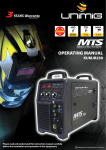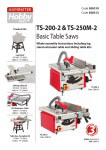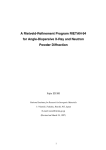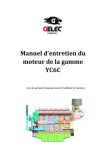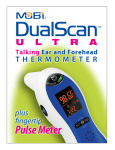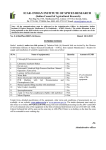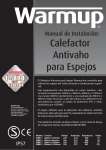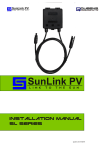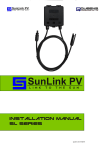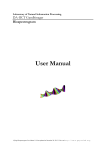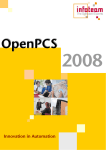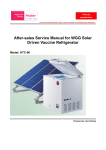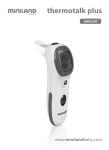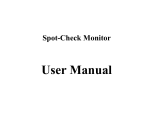Download AII5000B/B+ USER MANUAL - Medical Equipment & Gases Australia
Transcript
AII5000B/B+ USER MANUAL Instructions and Safety Considerations of Ambulanc Inhalation Analgesia Device Ambulanc(Shenzhen) Tech.Co.,Ltd. East 3/F.,Block A.,Nanyuan Ind.Park, Xinyuan Rd., Nanshan District, Shenzhen 518052,CHINA Tel.: +86-755 26072212 Fax: +86-755 33975117 Http: www.ambu-lanc.com FILE NO.: SP-160100028 VERSION: A1 ISSUE DATE: 2012-8-20 SP-160100028- AII5000B/B+ User Manual-A1 © COPYRIGHT AMBULANC (SHENZHEN) TECH.CO. ,LTD. 2012 ALL RIGHTS RESERVED Intellectual Property Statement AMBULANC (SHENZHEN) TECH.CO., LTD. (hereinafter called Ambulanc) owns the intellectual property rights to this Ambulanc product and this manual. This manual may refer to information protected by copyrights or patents and does not convey any license under the patent rights of Ambulanc, nor the rights of others. Ambulanc intends to maintain the contents of this manual as confidential information. Disclosure of the information in this manual in any manner whatsoever without the written permission of Ambulanc is strictly forbidden. Release, amendment, reproduction, distribution, rental, adaption and translation of this manual in any manner whatsoever without the written permission of Ambulanc is strictly forbidden. are the registered trademarks or trademarks owned by Ambulanc in China and other countries. All other trademarks that appear in this manual are used only for editorial purposes without the intention of improperly using them. They are the property of their respective owners. Responsibility Statement on the Manufacturer Party Contents of this manual are subject to changes without prior notice. All information contained in this manual is believed to be correct. Ambulanc shall not be liable for errors contained herein nor for incidental or consequential damages in connection with the furnishing, performance, or use of this manual. Ambulanc is responsible for the effects on safety, reliability and performance of this product, only if: z all installation operations, expansions, changes, modifications and repairs of this product are conducted by Ambulanc authorized personnel; z the product is used in accordance with the instructions for use. Warning z This equipment must be operated by skilled/trained clinical professionals. z It is important for the hospital or organization that employs this equipment to carry out a reasonable service/maintenance plan. Neglect of this may result in machine breakdown or personal injury. 1 / 21 SP-160100028- AII5000B/B+ User Manual-A1 Warranty THIS WARRANTY IS EXCLUSIVE AND IS IN LIEU OF ALL OTHER WARRANTIES, EXPRESSED OR IMPLIED, INCLUDING WARRANTIES OF MERCHANTABILITY OR FITNESS FOR ANY PARTICULAR PURPOSE. Exemptions Ambulanc's obligation or liability under this warranty does not include any transportation or irresistible natural disaster or other charges or liability for direct, indirect or consequential damages or delay resulting from the improper use or application of the product or the use of parts or accessories not approved by Ambulanc or repairs by people other than Ambulanc authorized personnel. This warranty shall not extend to z Malfunction or damage caused by improper use or man-made failure. z Malfunction or damage caused by force majeure such as fire and earthquake. z Malfunction or damage caused by improper operation or repair by unqualified or unauthorized service people. z Malfunction of the instrument or part whose serial number is not legible enough. z Others not caused by instrument or part itself. Safety Information Danger Indicates an imminent hazard that, if not avoided, will result in death or serious injury. Warning Indicates a potential hazard or unsafe practice that, if not avoided, could result in death or serious injury. Caution Indicates a potential hazard or unsafe practice that, if not avoided, could result in minor personal injury or product/property damage. Note Provides application tips or other useful information to ensure that you get the most from your product. 2 / 21 SP-160100028- AII5000B/B+ User Manual-A1 Product information Product Name: Inhalation Analgesia System Model: AII5000B/B+ Manufacturer: Ambulanc (Shenzhen) Tech. Co., Ltd. Manufacturer address:East 3/F, Block A Nan Yuan Ind. Park , XinYuan Rd, NanShan District, Shenzhen 518052, CHINA. Warning This device is not intended for home using! Company Contact Manufacturer: Ambulanc (shenzhen) Tech.Co., Ltd. Address: East 3/F, Block A Nan Yuan Ind. Park, XinYuan Rd, NanShan District, Shenzhen 518052, CHINA. Tel.: +86-755-26072212 26072280 Fax: +86-755- 33975117 Website: http://www.ambu-lanc.com E-mail: [email protected] EC-Representative: Shanghai International Holding Gorp. GmbH(Europe) Eiffestrasse 80 20537, Hamburg, Germany Contact Pers.: Qiming Cheng Telephone: +49-40-2513175 Fax: +49-40-255726 Preface Manual Purpose This manual contains the instructions necessary to operate the product safely and in accordance with its function and intended use. Observance of this manual is a prerequisite for proper product performance and correct operation and ensures patient and operator safety. This manual is based on the maximum configuration and therefore some contents may not apply to your product. If you have any question, please contact us. This manual is an integral part of the product. It should always be kept close to the equipment so that it can be obtained conveniently when needed. Intended Audience This manual is geared for clinical professionals who are expected to have a basic medical working knowledge. Illustrations All illustrations in this manual serve as examples only. They may not necessarily reflect the setup or data displayed on your device. 3 / 21 SP-160100028- AII5000B/B+ User Manual-A1 Contents 1. Safety Guide .............................................................................................................. 5 2. Overview.................................................................................................................... 7 2.1. Intended Application ........................................................................................ 7 2.2. Type ................................................................................................................ 7 2.3. Principle of Operation ...................................................................................... 7 2.4. Components List.............................................................................................. 8 2.5. Analgesia Pharmacology ................................................................................. 8 3. Installation and Debugging ........................................................................................ 9 3.1. Mainframe and Gas Installation ....................................................................... 9 3.2. Installation of gas cylinder ............................................................................. 10 3.3. Check the working pressure .......................................................................... 10 3.4. Check the flow rate of the mixed gas............................................................. 11 4. Description............................................................................................................... 12 5. Operating Instructions.............................................................................................. 13 5.1. Persistent Inhalation ...................................................................................... 13 5.2. Intermittent Inhalation .................................................................................... 14 6. Maintenance ......................................................................................................... 16 6.1. Detachable Parts ........................................................................................... 16 6.2. Main Body of AII5000B/B+ ............................................................................ 16 6.3. Respiration Loop ........................................................................................... 16 6.4. Maintenance Cycles ...................................................................................... 16 7.Trouble Shooting ...................................................................................................... 17 8. Specifications .......................................................................................................... 18 8.1. Safety Type ................................................................................................... 18 8.2 Working Environment ..................................................................................... 18 8.3 Performance ................................................................................................... 18 9. Product and Accessories ......................................................................................... 19 10. Warranty Statement ............................................................................................... 20 11. Storage and transportation .................................................................................... 21 4 / 21 SP-160100028- AII5000B/B+ User Manual-A1 1. Safety Guide ¾ AII5000B/B+ should be operated by qualified personnel only. ¾ AII5000B/B+ mixes oxygen and nitrous oxide gas through the manual adjustment; the blended gas is delivered to the patient by autonomous respiration to inhibit pain, so that patients can receive surgeries and treatment under sober state without injection of narcotics. It’s mainly used to relieve pain during childbirth in gynecology and operations in dental treatment, as well as to alleviate pain and discomfort during gastrointestinal endoscopy. Warning z This sedation system can’t be used for analgesia of headache and stomachache. z AII5000B/B+ is not to be used for mixing other blended gases. z The sedation system should be used in noncombustible environment in case of fire disaster and explosion. z Before using the machine, the operators must make sure that the sedation system is under normal working state and proper operating environment. z Only qualified professionals may disassemble AII5000B/B+. Any unauthorized repair, alternation or misuse of AII5000B/B+ will void warranty. z AII5000B/B+ blends high-pressure gases such as oxygen and nitrous oxide. Keep AII5000B/B+ clean and strictly avoid contact with grease and other dangerous lubricants. z Keep AII5000B/B+ away from direct heat-sources. z This sedation system shall not be used for long time, which means the discontinuous inhaling time shall not exceed 3-4 days and when having inhaled continuously for 2 hours, oxygen should be inhalated for 15 minutes discontinuously, for great amount of and long time of inhalation may cause suppression to bone marrow. z When usage of the sedation system is finished, the patients should inhale pure oxygen for 3-5 minutes to avoid diffusion anoxia, which will cause harm to cardiac muscle that is already oxygen deficient. z Contraindications: for patients with cardiopulmonary insufficiency, severe hypotension, upper respiratory tract infection, and gestational women (laughing gas should not be inhaled in the first three months of pregnant) or gestational women with pregnancy-induced hypertension or other obstetrical complications shall cautiously apply or not apply the sedation system. z The operator should query for detailed medical history before applying the device to patients, so as to avoid adverse reaction caused by gas volume increase in the bodies 5 / 21 SP-160100028- AII5000B/B+ User Manual-A1 of patients who have a medical history of tympanitis, intestinal obstruction and pneumoperitoneum (patients who had undertaken laparoscopic surgery). Caution z To ensure safety of patient, please use parts and accessories recommended by the company. z Do not use heat-conducting and electro-conductive respiratory tube. z AII5000B/B+ and all moving parts should be safely mounted, avoiding the aeration pipe dragging on the ground when moving the device. z The gases connected to AII5000B/B+ should be clean and dry to avoid malfunction. z Operator should check the gauges of gases to make sure they are in the right position before starting to use AII5000B/B+. z Gases discharged from AII5000B/B+ will not pollute environment, but the room must be well ventilated; otherwise, the combustion-supporting gases may pose risk of fire. z Double check all connections to ensure there are no leaks before AII5000B/B+ goes into service. z When using gas, the valve of the appliance shall not be switched on or off with overexertion. z Gases should be used in the ambient temperature of 5℃ and above. z To ensure AII5000B/B+ safety and long-term operation, please follow the instructions in the Manual. However, this manual cannot be a substitute for the established medical practice to treat patients. z Please conduct regular maintenance to AII5000B/B+. z Place the packaging materials of AII5000B/B+ where children cannot reach or dispose them in accordance with relevant environmental regulations. z AII5000B/B+ parts should be disposed of when they reach the end of their useful life cycle. Note z The above mentioned are the basic safety requirements; please refer to subsequent chapters for more detailed and specific safety requirements. z The level of importance of above mentioned safety requirements are arranged in random order. As well, the detailed safety requirements in subsequent chapters are as important as those in this chapter. 6 / 21 SP-160100028 AII5000B/B++ User Manual-A1 2. Overview 2.1. Intended Application AII5000B/B+ delivers mixed oxygen and nitrous oxide gases to the patient by autonomous respiration to inhibit pain, which is a simple, safe, efficient way of delivering pain relief in general dental treatment. It’s mainly used to relieve pain during childbirth in gynecology and operations in dental treatment, as well as to alleviate pain and discomfort during gastrointestinal endoscopy; it also applies to the conditions when changing dressing for burn patients and cases of minor cosmetic surgeries. Danger z This sedation system can’t be used for analgesia of headache and stomachache. z This sedation system cannot be used for treatment. 2.2. Type AII5000B/B+ type: Gas sources are oxygen and nitrous oxide. The ratio between oxygen and nitrous oxide is continuously adjustable. The minimum content of oxygen should be 30%. Doctors can adjust the content of oxygen and nitrous oxide according to different patients. 2.3. Principle of Operation AII5000B/B+ blends medical oxygen and medical nitrous oxide by connecting to oxygen cylinder and nitrous oxide cylinder. The gases flow through the stainless steel passages independently into the oxygen and Nitrous Oxide modules; the operator can adjust the ratio between oxygen and nitrous oxide through regulating the knob on the mixer of nitrous oxide (laughing gas) and oxygen manually. Then blended through the blending module and flows into patients’ respiratory loop and the breathing operation are carried out by the inspiration control valve and mask. 7 / 21 SP-160100028 AII5000B/B++ User Manual-A1 Fig. 1 Fundamental Diagram 2.4. Components List This sedation system is composed of Trolley, nitrous oxide / oxygen blender, Pressure indicator, demand valve, mask, oxygen source and nitrous oxide source. 2.5. Analgesia Pharmacology Laughing gas is nitrous oxide, and its molecular formula is N20. It is a type of colorless and sweet inert gas, with stable chemistry performance, incombustible, inexplosive, and combustion-supporting. It realizes the pharmacological effect by inhibiting the release of the excitatory neurospongium and the conduction of nerve impulse of central-nervous system, and changing the permeability of ion channel. Laughing gas is non-toxic inhalation analgesia or anesthesia, which has no stimulation to the respiratory tract, does not combine with hemoglobin, causes no damage to the function of heart, lung, liver, and kidney, nor suppression to circulatory system, and does not affect the blood pressure, pulse and fetal heart of patients. The minimum effective concentration of the alveolar air (MAC) is 105, with a quick analgesic effect after being inhaled into human body 30-45 seconds later. A few minutes after the termination of the inhalation, 90% of nitrous oxide can be exhausted quickly from the alveolar and a small amount of nitrous oxide is evaporated through the skin. 8 / 21 SP-160100028 AII5000B/B++ User Manual-A1 3. Installation and Debugging 3.1. Mainframe and Gas Installation 1) Take out the trolley and the mainframe from the packing box, and check the accessories carefully according to the packing list. 2) Fix the mainframe to the fixing bracket and fasten the pinching screw. The pinching screw 3) Get the oxygen pipeline and nitrous oxide pipeline through the trolley pipe hole, connect them to the pressure reducing valves respectively (the blue valve is for oxygen pressure reducing, while the gray one for nitrous oxide) and afterward tightened with a wrench. 4) Connect the other end of oxygen pipeline and nitrous oxide pipeline to their respective gas inlet on AII5000B/B+ main unit, and gently tightened with a wrench. Oxygen pipeline Nitrous oxide pipeline Mixed Gas pipeline 9 / 21 SP-160100028 AII5000B/B++ User Manual-A1 5) Connect the mixed gas pipeline to the outlet on AII5000B/B+ Main unit. And connect the other end of mixed gas pipeline to respiratory controller (DVR) and mask. DVR Mask Mixed gas pipeline connector 3.2. Installation of gas cylinder 1) Open the trolley, place the N2O cylinder and O2 cylinder according to the gas cylinder position loaded, and check the pressure gauges of N2O and O2 to make sure that the range of gauge is 25 Mpa. 2) Install the gas cylinder. Cylinders placed by color, trap the cylinder valve with pressure reducer fixation, align the cylinder location pin with cylinder nozzle and holder, and then lock the fixation pin. 3) Close the trolley door. 3.3. Check the working pressure 1) Check whether the working pressure gauges of O2 and N2O point at the position of 0.3-0.4Mpa. If so, it shows that the working pressure is within the acceptability limit, if not, adjustment will be needed. 2) If the delivery pressure is not within this limit, check as follows (for some models, the pressure gauges do not require adjustment; please confirm when installing): a) Open the trolley door; b) For the oxygen decompression valve, unscrew the nut, and then turn the bolt toward left or right (turning left reduces the pressure while turning right increases the pressure); check the oxygen output pressure gauge (as the same in step 1) until it indicates a value between 0.3-0.4 Mpa. c) For the nitrous oxide decompression valve, unscrew the nut, and then turn the bolt toward left or right (turning left reduces the pressure while turning right increases the 10 / 21 SP-160100028 AII5000B/B++ User Manual-A1 pressure); check the nitrous oxide output pressure gauge (as the same in step 1) until it indicates a value equivalent to that of oxygen output pressure gauge. Screw on the nut again after adjustment. d) Close the trolley door. Caution z Output pressure adjustment has been done before the system leaves factory, whereas some irresistible factors during the transportation or change of environment may result in pressure change, so it requires pressure checking as in step one to ensure that the pressure is within the acceptability limit; if the pressure is not within the acceptability limit, please refer to the steps in 2 for adjustment. (During the process of adjustment, when the output pressure of nitrous oxide and oxygen are not balanced, a warning will keep ringing until a balanced condition is reached.) z After period of Normal use, when a gas reduces to a certain amount, AII5000B/B+ will alarm to remind operator change the cylinder at this time. 3.4. Check the flow rate of the mixed gas 1) Adjust the ratio of the O2 to 100%, cover the mask to the patient’s face for inhalation, and check whether the flow rate of the gas is appropriate. 2) Respectively adjust the ratio of the O2 to 70% or 30%, and adopt the similar method to check if the gas flow is appropriate. 3) If the flow is too small, please respectively increase the working pressure of the N2O and oxygen appropriately, but no more than the limit range of 0.4Mpa. 4) Recheck the flow rate with the methods mentioned in 1 and 2 Note z The adjustments above have been done before the system leaves the factory. It is unnecessary to readjust any more, unless it is out of special requirements. z When finishing adjusting the delivery pressure of nitrous oxide and oxygen appropriately, DO NOT open the trolley door and adjust the pressure valve during operation or the process of changing gas cylinders. 11 / 21 SP-160100028 AII5000B/B++ User Manual-A1 4. Description Mixed Gas Pressure Gauge Concentration Adjustment Pressure Gauge Demand Valve Timer Resuscitator (DVR) with Mask Mixed Gas Pipeline Trolley Accessory Box 12 / 21 SP-160100028 AII5000B/B++ User Manual-A1 5. Operating Instructions 5.1. Persistent Inhalation 5.1 .1 Adaptation Diseases This machine is mainly used to relieve pain during childbirth in gynecology and operations in dental treatment, as well as to alleviate pain and discomfort during gastrointestinal endoscopy. 5.1 .2 Operating Process 1) The medical personnel should do the routine examination, inquire about related disease history of the patient and record it before the operation (The system does not apply to patients with respiratory diseases). 2) Open the valve switch of the O2 cylinder and the valve switch of the N2O cylinder. Check whether the pressure indicators of each pressure gauge is at the correct location, and adjust the ratio between the O2 and NO2 according to the operation needs (adjust according to the actual situation, it’s strongly recommended that Titration method should be used to adjust the ratio and generally the nitrous oxide ratio for adults is 50% -60%). 3) When all the preparations have been completed by the doctors, the assistant put the mask close to the patient’s mouth and nose, fix it perfectly, and ask the patient to take 3-7 deep breath slowly by the mouth. Then the patient turns to breathe calmly, and wait a moment and observe for a while (around 10 seconds). When the patient’s facial expression calms down or forehead turns flush, palms sweat, consciousness becomes slightly confused and the patient breathes normally, it shows the sedation is effective, and the doctors can start the operation. (If the patient is nervous and uncooperative, ask him/her to relax; at the same time, appropriately increase the concentration of the laughing gas for his/her breathing. Please bear in mind that the recommended time interval of adjusting the concentration should be once per minute.) Note z Deep breath refers to inhaling gas as long as possible, then relaxing and breathing out slowly. 4) In the course of operation, the assistant should observe the patient consistently and carefully (including facial color and expression, eyelash reflex, breathing, etc.). If the patient’s facial expressions a slight pain, let patient take a deep breath 3-5 times then remove the mask until the end of operation. Positive psychological suggestion, peaceful surrounding environment and gentle and friendly operation are key to a successful sedation operation. At the end of the operation, regulate the concentration knob and adjust the oxygen concentration to 100%, stop supplying the N2O, and make the patient breathe in pure oxygen. 13 / 21 SP-160100028 AII5000B/B++ User Manual-A1 5) Around 30-60s later, the patient will be awake. After the operation finished, let the patient keep inhaling pure oxygen for 3-5 minutes until he/she is totally awake. 6) After using of the system is finished, please turn off the valves of the two gas sources; firstly turn off laughing gas, and then oxygen. 5.2. Intermittent Inhalation 5.2.1Adaptation Diseases It’s mainly used to relieve pain during childbirth in gynecology and also applies to the conditions when changing dressing for burn patients and cases of minor cosmetic surgeries. 5.2.2 Operating process 1) The medical personnel should do the routine examination, inquire about related disease history of the patient and record it before the operation (The system does not apply to patients with respiratory diseases). 2) Open the gas sources: turn on the valve switch of the gas sources, and the pressure gauge will increase slowly. Adjust the oxygen rotary switch to supply 50% oxygen. (adjust according to the actual situation, the nitrous oxide ratio can be started at 70%(O2 concentration 30%) and it’s strongly recommended that Titration should be used to inhale) 3) The patient holds the mask by himself, covering his mouth and nose closely without gaps. Firstly make patients spontaneously and continuously take a deep breath 5 ~ 8 times, then remove mask. When patient feels pain, continuously take a deep breath 5 ~ 8 times until the end of the operation. 4) Due to individual differences, every inhaling amount is generally 5 times of deep breath or so. Note z The amount every time shall not be more than 10 times, pay attention do not allow patients to inhale at will. z In the course of operation, if somnolence, coma, cough, etc. occurs, stop using the mixed gas immediately and offer pure oxygen for patients (The rapid oxygen supply switch can be used for inhaling high flow rate of oxygen). A few minutes later, the patient will recover spontaneously. 5) After using of the system is finished, please turn off both the valves of the two gas source. Firstly turn off the valve of nitrous oxide, and then the valve of oxygen. Note z Since it needs 30-50 seconds of conduction period for analgesia taking effect after laughing gas is breathed into human body, the inhalation must begin at 30 seconds before the pain happens so that the analgesic effect of the laughing gas could 14 / 21 SP-160100028 AII5000B/B++ User Manual-A1 synchronize with the appearance of the pain. Positive psychological suggestion, peaceful surrounding environment are key to a successful sedation operation. z There are individual differences of patient's sensitivity and tolerance to the laughing gas. Medical personnel should monitor saturation of blood oxygen and pulse rate, analgesic effect and adverse reactions, such as dizziness, fatigue, somnolence or uncooperative situation. Once these situations occur, it indicates that the patient has inhaled excessive gas, and if so, inhalation times should be reduced in time to ensure safety. z When inhaling the gas, the patient should take deep breath so that the gas can accelerate the participation of the body-internal-circulation. Warning z As for the sedation system, when the delivery pressure of any gas source is too low, the sedation system would alarm. z Stop using the system when alarms ring. Check if the gas or pressure is deficient. Please re-replace the gas source or readjust the system according to the methods in Chapter III. If readjustment does not help, it is usually the gas of low delivery pressure has been exhausted, so it is necessary to replace the gas source. In general case, alarming means that one of the gas sources has been exhausted; if so, directly replacing the gas source. However, there are possibilities that in individual cases, other factors which cause unbalanced pressure lead to alarms. Note z All valve switches of the gas sources should be turned off when the system is not used for a long time, when the patient’s respiratory loop, reducing valve, nasal mask are replaced for cleaning and or when the system is transported other places for usage. 15 / 21 SP-160100028 AII5000B/B++ User Manual-A1 6. Maintenance 6.1. Detachable Parts ¾ Patient respiratory loop or respiratory control device ¾ Gas cylinder 6.2. Main Body of AII5000B/B+ To clean the AII5000B/B+, use a soft cloth dipped in warm soapy water to wipe the surface of AII5000B/B+; then wipe with a dry cloth. Avoid liquid from running into the main body of AII5000B/B+. Caution z Do not sanitize the main body of AII5000B/B+ under high pressure and high temperature condition. Do not sanitize the main body by soaking in any kinds of liquid. z Do not spill any liquid on the unit; do not let liquid flow into connectors on the unit. z For parts need sanitization, temperature should not exceed 100°C. z When the unit is found damaged or dysfunctional, stop using the AII5000B/B+ and contact maintenance professionals. 6.3. Respiration Loop 6.3.1 The disinfector used should be based on following chemicals ¾ Acetaldehyde ¾ Ethanol ¾ Quaternionic amino-group compound 6.3.2 Sterilization methods Moist-heat sterilization (only applicable to Reusable mask) ¾ Only soft detergents can be used. ¾ 93 ℃ high temperature for 15-30 minutes High-temperature steam sterilization: ¾ Superheated steam of 134℃ should be used. (only applicable to silica gel subassemblies) 6.4. Maintenance Cycles Every one month Inspection and maintenance must be performed by the persons certified by the company. 16 / 21 SP-160100028 AII5000B/B++ User Manual-A1 7. Trouble Shooting ¾ There is no mixed gas flow when inhaling with mask a) Check source gas gauges, replace the cylinder or check other source gas pressure if the pressure of the source gas is lower than 3 Bar. b) Check delivery pressure gauge, adjust the delivery pressure valve if the pressure is lower than 3 Bar. c) Check the pressure of the respiratory loop connector; if there is no pressure or no gas blowing out, request authorized professional personnel to maintain and clean the control module. d) If there is no problem with the above three items, the respiratory control unit should be replaced. ¾ The flow rate is too high or too low a) Adjust the delivery pressure valve to the proper position. b) Replace the respiratory control unit. ¾ Oxygen content is wrongly read. It should be adjusted by authorized professional personnel. ¾ Machine alarms. a) Check if the source gas is open or the source gas exhaustion. b) Knock the alarm post to observe whether the resilient strip resumes to the original position. c) Check if the airway is blocked or pipe bending. 17 / 21 SP-160100028 AII5000B/B++ User Manual-A1 8. Specifications 8.1. Safety Type Type of Device: Passive device Risk Classification: Class II 8.2 Working Environment Working temperature: 20℃~45℃ Relative humidity: ≤80% Atmospheric pressure: 76~106kPa 8.3 Performance Analgesia starts to work: 30-50 seconds Analgesia peak period: 40-120 seconds N2O completely breathing out: 5minutes A. Respiratory parameters: Tidal volume: independently control by the patient Flow rate: independently control by the patient Pressure limit: 0-60cm H2O (controlled by demand valve) Fresh gas compensation: automatic compensation tidal volume B. Inhalation mode: Spontaneous breathing pattern Accessories: Outline dimensions of main body: Weight: Cylinder (10Lmax, Ф140 mm x 900 mm) 560mm (length) x470mm (width) x1100mm (height) 25kg 18 / 21 SP-160100028 AII5000B/B++ User Manual-A1 9. Product and Accessories Parts Part No. QTY(PCS) Mainframe C10084 1 Trolley(Optional) Y30399 1 Stand(Optional) Mixed gas pipeline Y20820 Y50064 1 1 DVR B10001 1 Silicon Mask Y50065 1 Rubber belt Y50243 1 Disposable mask Y50066 5 Accessory Box(Optional) Y50359 1 O2 input gas(White) B20667 1 N2O input gas(Blue) B20665 1 Key for trolley N/A 1 Caution For details,please check packing list. 19 / 21 SP-160100028 AII5000B/B++ User Manual-A1 10. Warranty Statement THIS WARRANTY IS GIVEN IN PLACE OF ALL OTHER WARRANTIES, EXPRESS OR IMPLIED, OF MERCHANTABILITY, FITNESS FOR A PARTICULAR PURPOSE OR OTHERWISE. Under no circumstances shall Manufacturer be liable for incidental or consequential damages as those terms are defined in the uniform commercial code. Manufacturer warrants that each product or part shall be free from defects in workmanship and materials, under normal use and with appropriate maintenance, for one (1) year from the date of delivery to customer unless otherwise specified in writing. All rubber and plastic parts and accessories are warranted under the same conditions for a period of ninety (90) days from date of purchase. The main components are warranted under the same conditions for a period of 1 year from the date of purchase. Please check manual for the detailed warranty services. No statement or claim about the product by any employee, agent, representative, or dealer of Manufacturer shall constitute a warranty by Manufacturer or give to rise any liability or obligation of Manufacturer. Manufacturer shall not be liable for any damage, injury or loss arising out of the use of the product, whether as a result of a defect in the product or otherwise, if, prior to such damage, injury or loss, the product was (1) damaged or misused; (2) repaired, altered or modified by persons other than Manufacturer; (3) not installed in strict compliance with applicable codes and ordinances; or (4) not installed by an authorized Manufacturer dealer. Manufacturer obligation for breach of this warranty, or for negligence or otherwise, shall be strictly and exclusively limited to the repair or replacement of the product or part. This warranty shall be void on any product on which the serial number has been altered, defaced or removed. RETURNS & EXCHANGE No returns or exchange will be accepted unless authorized in writing by Manufacturer Instrument Division, and accompanied by a properly completed return goods authorization. All returns are subject to a re-stocking and possible rework charges to be determined by Manufacturers Instrument Division. Policies are subjected to change without prior notice. 20 / 21 SP-160100028 AII5000B/B++ User Manual-A1 11. Storage and transportation Working Temperature 20-45℃ Upward Number of plies 2 levels Handle with care Avoid moisture 21 / 21 Ambulanc(Shenzhen)Tech.Co.,Ltd. ADD.: East 3/F.,Block A.,Nanyuan Ind.Park, Xinyuan Rd.,Nanshan District, Shenzhen 518052,CHINA TEL.:+86-755 26072212 26072280 FAX:+86-755 33975117 WEBSITE: www.ambu-lanc.com E-MAIL:[email protected] Print in CHINA LN: 5000BSMS201202 Ver.: A1 (2012)























